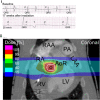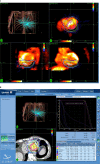Ablative Radiotherapy as a Noninvasive Alternative to Catheter Ablation for Cardiac Arrhythmias
- PMID: 28752279
- PMCID: PMC5532420
- DOI: 10.1007/s11886-017-0886-2
Ablative Radiotherapy as a Noninvasive Alternative to Catheter Ablation for Cardiac Arrhythmias
Abstract
Purpose of review: Stereotactic radioablation is a commonly utilized technology to noninvasively treat solid tumors with precision and efficacy. Using a robotic arm mounted delivery system, multiple low-dose ionizing radiation beams are delivered from multiple angles, concentrating ablative energy at the target tissue. Recently, this technology has been evaluated for treatment of cardiac arrhythmias. This review will present the basic underlying principles, proof-of-principle studies, and clinical experience with stereotactic arrhythmia radioablation.
Recent findings: Most recently, stereotactic radioablation has been used to safely and effectively treat a limited number of patients with malignant arrhythmias, including ventricular tachycardia (VT) and atrial fibrillation (AF). Treatment protocols, outcomes, ongoing studies, and future directions will be discussed. Stereotactic radioablation is a well-established technology that has been shown to be a safe and effective therapy for patients with drug-refractory cardiac arrhythmias, including VT and AF. Further clinical evaluation to define safety and efficacy in larger populations of patients is needed.
Keywords: Ablation; Atrial fibrillation; Noninvasive; Radiosurgery; Stereotactic; Ventricular tachycardia.
Conflict of interest statement
Conflict of Interest
Paul C. Zei has received research support from Cyberheart, Inc.
Scott Soltys is a consultant for Nektar Therapeutics.
Human and Animal Rights and Informed Consent
All reported studies/experiments with human or animal subjects performed by the authors have been previously published and complied with all applicable ethical standards (including the Helsinki declaration and its amendments, institutional/national research committee standards, and international/national/institutional guidelines).
Figures



Similar articles
-
Ablative radiosurgery for cardiac arrhythmias - A systematic review.Cancer Radiother. 2021 Jun;25(4):373-379. doi: 10.1016/j.canrad.2021.01.009. Epub 2021 Feb 13. Cancer Radiother. 2021. PMID: 33589330
-
Stereotactic arrhythmia radioablation for refractory scar-related ventricular tachycardia.Heart Rhythm. 2020 Aug;17(8):1241-1248. doi: 10.1016/j.hrthm.2020.02.036. Epub 2020 Mar 6. Heart Rhythm. 2020. PMID: 32151737
-
Stereotactic arrhythmia radioablation: A novel therapy for cardiac arrhythmia.Heart Rhythm. 2023 Sep;20(9):1327-1336. doi: 10.1016/j.hrthm.2023.04.052. Epub 2023 May 5. Heart Rhythm. 2023. PMID: 37150313 Review.
-
Stereotactic Arrhythmia Radioablation as a Novel Treatment Approach for Cardiac Arrhythmias: Facts and Limitations.Biomedicines. 2021 Oct 13;9(10):1461. doi: 10.3390/biomedicines9101461. Biomedicines. 2021. PMID: 34680578 Free PMC article. Review.
-
Phase I/II Trial of Electrophysiology-Guided Noninvasive Cardiac Radioablation for Ventricular Tachycardia.Circulation. 2019 Jan 15;139(3):313-321. doi: 10.1161/CIRCULATIONAHA.118.038261. Circulation. 2019. PMID: 30586734 Free PMC article. Clinical Trial.
Cited by
-
Stereotactic Radiotherapy for the Management of Refractory Ventricular Tachycardia: Promise and Future Directions.Front Cardiovasc Med. 2020 Jun 25;7:108. doi: 10.3389/fcvm.2020.00108. eCollection 2020. Front Cardiovasc Med. 2020. PMID: 32671101 Free PMC article. Review.
-
Ventricular Tachycardia: A Treatment Comparison Study of the CyberKnife with Conventional Linear Accelerators.Cureus. 2018 Oct 12;10(10):e3445. doi: 10.7759/cureus.3445. Cureus. 2018. PMID: 30555760 Free PMC article.
-
Stereotactic arrhythmia radioablation (STAR) opens a new era in the treatment of arrhythmias?Front Cardiovasc Med. 2024 Sep 27;11:1449028. doi: 10.3389/fcvm.2024.1449028. eCollection 2024. Front Cardiovasc Med. 2024. PMID: 39399514 Free PMC article. Review.
-
Adverse cardiac effects of cancer therapies: cardiotoxicity and arrhythmia.Nat Rev Cardiol. 2020 Aug;17(8):474-502. doi: 10.1038/s41569-020-0348-1. Epub 2020 Mar 30. Nat Rev Cardiol. 2020. PMID: 32231332 Free PMC article. Review.
-
Evaluation of the impact of cardiac implantable electronic devices on cine MRI for real-time adaptive cardiac radioablation on a 1.5 T MR-linac.Med Phys. 2025 Jan;52(1):99-112. doi: 10.1002/mp.17438. Epub 2024 Oct 4. Med Phys. 2025. PMID: 39365684 Free PMC article.
References
-
- Kirchhof P, Benussi S, Kotecha D, Ahlsson A, Casadei B, Castella M, Diener HC, Heidbuchel H, Hendriks J, Hindricks G, Manolis AS, Oldgren J, Popescu BA, Schotten U, Van Putte B, Vardas P, Agewall S, Camm J, Esquivias GB, Budts W, Carerj S, Casselman P, Coca A, De Caterina R, Deftereos S, Dobrev D, Ferro JM, Filippatos G, Fitzsimons D, Gorenek B, Guenoun M, Hohnloser SH, Kolh P, Lip GYH, Manolis A, McMurray J, Ponikowski P, Rosenhek R, Ruschitzka F, Savelieva I, Sharma S, Suwalski P, Tamargo JL, Taylor CJ, Van Gelder IC, Voors AA, Windecker S, Zamorano JL, Zeppenfeld K. 2016 ESC Guidelines for the management of atrial fibrillation developed in collaboration with EACTS. Europace. 2016;18(11):1609–1678. doi: 10.1093/europace/euw295. - DOI - PubMed
Publication types
MeSH terms
LinkOut - more resources
Full Text Sources
Other Literature Sources
Medical
Research Materials

